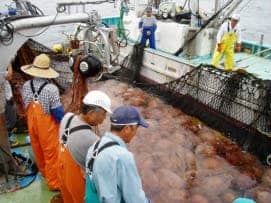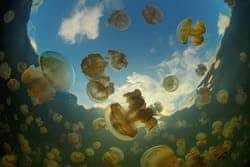Healthy wildlife populations aren’t always good news.
- Sweden’s largest nuclear power plant had to be shut down for three weeks in September after a mass of jellyfish clogged its cooling water inlet.
- A swarm of baby jellyfish essentially destroyed Northern Ireland’s farmed-salmon population in 2008 through stings and oxygen deprivation.
- A Japanese trawler capsized in 2009 trying to pull its fishing net from the water. The net was full of jellies.
Global jellyfish populations are surging and marine scientists are sounding alarms – some of them dire. Biologist Lisa-ann Gershwin, author of Stung! On Jellyfish Blooms and the Future of the Ocean, states that jellyfish could displace Antarctic penguins, devastate world fisheries, and even starve whales to extinction.
Are things really that serious? There’s plenty of evidence that jellyfish invasions (or “blooms”) inflict significant damage on ecosystems and economies and that blooms are increasing. Unfortunately, science is finding that these problems are largely effects of . . . us.
Not on anyone’s endangered list
Jellyfish are well-designed for surviving changed conditions. Their bodies are more than 95 per cent water, so growing doesn’t increase metabolic demands as much as it does in more complicated creatures.
Jellies are also unique in their ability to reduce their body size when food is scarce and to grow again when food is plentiful. Their lower metabolic rate also means a low oxygen requirement, which can be very useful in polluted waters
And jellies can eat just about anything, including young fish, fish eggs, and plankton. Their diet that can decimate fish populations and, because plankton remove carbon dioxide from the water, their diet can contribute to climate change.

Such adaptability has paid off. Today, there are 1,000 – 1,500 known types of jellyfish. Jellies and their phylogenetic cousins represent up to one third of the world’s marine biomass and, in some regions, they exceed fish biomass more than three to one.
Jellyfish may be the tribbles of the ocean.
We’re here to help
While jellyfish come with all the right tools for success, humans make things a lot easier for them. Piers, oil platforms and floating trash, for example, serve as ideal jellyfish nurseries, providing the good anchoring surfaces that polyps need for growth.
Human activity also provides useful transportation. Jellies travel in the ballast water of ships and are dropped off in new ports when that water gets dumped. An even easier way to catch a ride is on the hulls of ships (known as “hull-fouling”). In fact, ships may be responsible for almost 70 percent of the transport of non-native marine species around the world.

Even land activities work to tilt the survival advantage in favor of jellies. Fertilizers and other runoff can strip oxygen from sea water (a process known as eutrophication) but, because jellyfish tolerate low oxygen better than other marine animals, they can thrive to the detriment of almost everything else. Jellies can be found in some seas that are otherwise “dead zones” from fertilizer runoff.
The most direct effect of human activities is probably overfishing, which simply removes jellyfish predators and competitors from the environment. Jellyfish blooms seen in the Black Sea and off of South Africa, for example, were likely due to overfishing of anchovies, which would otherwise compete with jellies for food.
A lack of good data
The consequences of jellyfish blooms would seem to be increasingly easy to identify. The salmon killed by the 2008 jellyfish bloom near Northern Ireland, for example, were valued at $2 million. Jellyfish eventually caused the complete collapse of Black Sea anchovy and sardine fisheries by devouring the fish’s food, their eggs, and their young. Power plants in Scotland, Japan and Israel have also been temporarily shut down when jellyfish clogged their cooling-water intake systems.
The problems would seem to be growing increasingly urgent, too. Fears that jellyfish are taking over the oceans have escalated in the past decade with increasing numbers of bloom reports. The clearest stories may be the Nomura jellyfish blooms off Japan: While only three blooms were recorded between 1920 and 1995, six blooms were recorded between 2002 and 2010. Not an encouraging trend.
Despite anecdotes and field reports, however, not everyone is ready to predict calamity. Some scientists don’t believe that there’s yet enough solid data to characterize a problem or to design countermeasures. Consequently, they’re now trying to fill some of the holes in the data record with new programs and new technologies. Citizen scientists are also being recruited to aid in the effort to expand our knowledge of jellies.
Jellyfish are believed to be at least 500 million – 700 million years old. That they preceded most other creatures in the sea and are still thriving today is reason enough to respect the hazard that jellies present if they continue to move and displace other species. Science is concerned but not panicked.
It’s rare to see the effects of common human activities align so conveniently to “aid” a part of nature. While future activities may change things, jellies seem built to take advantage of all we have to offer them today.






